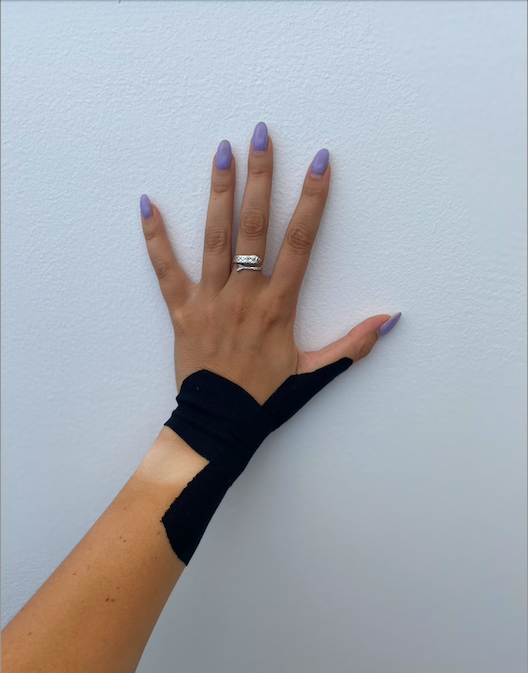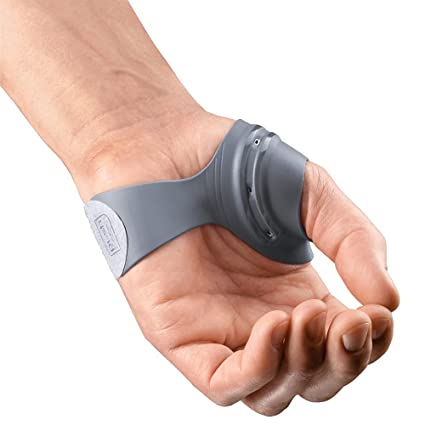Thumb arthritis is very common and affects roughly 30-50% of all people over the age of 50.
Wearing a support on the thumb can help to reduce pressure through the carpometacarpal (CMC) joint, reduce pain, and allow you to continue to do the tasks that are important to you.
When searching for the right thumb support you may feel overwhelmed. There are a lot of options on the market and with a simple google search, but how do you know which one may be right for you?
Here are a few things to consider when searching for a thumb splint for arthritis:
- Level of support
- Comfort
- Customization
- Cost
In this post we will outline 5 different types of thumb supports for arthritis in terms of these 4 criteria: level of support, comfort, customization, cost. We will also look at who should try each type of support.
Click to skip to each one
- Athletic Tape
- Kinesiology Tape
- Neoprene Thumb Support
- Polyurethane Thumb Support
- Custom Thumb Orthotic
1.) Athletic Tape

Who should try this?
This is a low-cost method to see if having some support at your thumb during activity helps reduce symptoms. Since the tape does not completely immobilize your joint, it may be best for someone who is new to trying support for their thumb or someone in the early stage of the disease. It is a good way to trial support on the thumb while doing activity to see if the pain or symptoms resolve.
Athletic Tape can be found at your local pharmacy or drug store as well as online on Amazon. There are a number of different ways to apply the athletic tape.
Level of support: Depending on the application method, support level can vary. You can choose to apply it to your MP joint or your CMC joint, depending on where you feel your arthritis pain and symptoms. In general, when you have the athletic tape donned you will still be able to move your hand and your thumb and be able to use that thumb for functional tasks but the tape is pretty rigid.
Comfort: Most people find this pretty comfortable, unless you are irritated by adhesives.
Customization: You can customize the tape in a variety of ways since it is removable
Cost: You can get a roll of this on Amazon for about $7, Target for about $3, or Walgreens for about $6.
2.) Kinesiology Tape

Kinesiotape was developed in the 1970s by Dr. Kenzo Kase. He designed it to mimic the human skin to allow for mobility and not limit range of motion like traditional tapes often do.This type of tape provides support during movement.
One theory behind kinesiotape, is that it helps to gently lift the top layer of the skin away from the subcutaneous tissue beneath it. This helps to change the signal on the pain pathways.
Kinesiotape tape is sold in a variety of different lengths, colors, and is sold by over 50 different brands.
Who should try this?
Kinesiology tape is great for someone who feels mild symptoms throughout the day that are exacerbated with activity. Since kinesiology tape can be applied in a number of different methods that you can try all with one roll, it’s a good cost-effective treatment to start. If you have advanced thumb arthritis, kinesiology tape may not provide enough support to immobilize the joint but could be a good option to wear during the day or even under a more supportive brace.
Level of support: Kinesiotape tape is designed to be worn while you move so it does not completely immobilize the joint. The tape uses other principles to help reduce pain like neuromuscular feedback and pain modulation. Level of support can also vary on the application method.
Comfort: Most people generally find this pretty comfortable, unless you are irritated by adhesives.
Customization: There are options to purchase this with different levels of water resistance, adhesive levels, materials, and cut lengths which contribute to customization. Application methods are also customizable based on where you feel the symptoms, how taught you pull the tape, and which method you use.
Cost: A roll of kinesiotape can be found on Amazon for $12 a roll or Walgreens for $15.
Note: Tape also comes in a variety of colors depending on brand, there is no difference between color, just personal preference.
3.) Neoprene Thumb Support

Who should try this?
If you’re looking for an easy application, relatively inexpensive support to wear this might be a good option. This could be an option to wear during night time due to its easy application and general comfort. This would probably not be a good option if you are someone who either has really small or really large hands or if you are doing work activities that require a lot of hand washing or getting your hands wet.
Level of support: This neoprene thumb stabilizer can help support the thumb joints. This one in particular leaves the fingertip free and supports the thumb CMC joint, the one closest to the wrist. Since the fabric is still moveable, you can still get some movement at the CMC, so it does not completely immobilize the joint.
Comfort: These can be pretty comfortable for people as long as they fit right. If they are too big, they can cause irritation from sliding around on the skin. If they are too small, they can also cause irritation and redness on the skin. One thing to note is that they can’t get wet because the fabric absorbs water.
Customization: This support comes universal for left or right with an adjustable strap. It’s advertised as universal but likely would not fit someone with very small hands or very large hands.
Cost: This support can be found on Amazon for $19.99. Another brand of a similar neoprene thumb support can be found at Walmart for $15.
4.) Polyurethane Thumb Support

Who should try this?
If you experience thumb CMC arthritis, this type of support is often the most recommended over the counter type of support. Mostly often recommended for its immobilization at the CMC joint while leaving other parts of the hand free, ease of application, and material that can get wet and dirty but clean easily. The one caveat that may turn you away is the high price tag of roughly $100.
Polyurethane thumb supports use a hard plastic material to provide support to the hands. Typically these are made to support the thumb CMC joint. The most popular plastic thumb splice is a Push Metagrip splint.
Level of support: This support provides a high level of support to the thumb CMC joint and immobilizes it while keeping the other joints of the hand and fingers free to move around.
Comfort: Most people find this pretty comfortable. However, after time they can rub on the skin and leave redness and blisters, if you are not watching out for your skin.
Customization: The push metagrip thumb support does come in 4 different sizes, x-small, small, medium, and large and has one adjustable strap that wraps around the wrist.
Cost: You can find this on Amazon for roughly $100 or on Oh My Arthritis for $82.
5.) Custom Thumb Orthotic

Who should try this?
If you want a customized support, getting a referral to a hand therapist might be your best bet. These splints are fabricated out of molded plastic but are only fabricated by hand therapists.
If you are referred to a hand therapist for occupational therapy, they may fabricate you a custom thumb spica orthotic. These are constructed by molding hard plastic to your hand to custom fit your hand and your needs. They can be adjusted over time with the use of heat to mold the plastic.
Level of support: Since this is customized by an OT or hand therapist the level of support can vary.
Comfort: The hard plastic itself used is often not comfortable but the therapist can add piece of moleskin fabric or can add layers of comfort to reduce pressure points.
Customizable: These supports are completely customizable by the therapist in terms of size, material, shape and strapping.
Cost: These may be covered by your insurance as a part of your treatment plan or you may have to pay some or all of it out of pocket, which can be upwards of hundreds of dollars, depending on your insurance plan.
Conclusion
When choosing the right arthritis thumb support, you may find that it is beneficial to have more than one option to choose from. In some cases, you may need one with more support when doing a difficult task like cleaning, lifting weights, or grocery shopping and a different support when you are sleeping or sitting on the couch.
If you are still unsure about which splint might work best for you. You can meet with an occupational therapist through the Reactiv app to get support.
Reactiv may be covered by your insurance. To see if you are eligible, provide your information and we will reach out to you.
Disclaimer: This post is for general informational purposes only. It should not be used to self-diagnose and it is not a substitute for a medical exam, cure, treatment, diagnosis, and prescription or recommendation. You should not make any change in your health regimen, exercise regimen, or diet before first consulting a physician and obtaining a medical exam, diagnosis, and recommendation. Reactiv Inc. is not liable or responsible for any advice, course of treatment, diagnosis or any conclusions drawn, services or product you obtain through this post, video, infographic, table, photos, or site.
